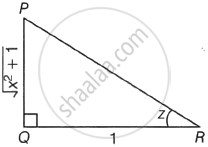Advertisements
Advertisements
प्रश्न
sin [cot–1 (cos (tan–1 x))] = ______.
पर्याय
`sqrt((x^2 - 1)/(x^2 + 2))`
`sqrt((x - 2)/(x^2 + 1))`
`sqrt((x^2 + 1)/(x^2 + 2))`
`1/sqrt(x^2 - 1)`
उत्तर
sin [cot–1 (cos (tan–1 x))] = `underlinebb(sqrt((x^2 + 1)/(x^2 + 2)))`.
Explanation:
Let tan–1 x = y ...(i)
tan y `\implies` tan y = y = x / 1

In ΔABC,
tan y = AB / BC = x
By Pythagoras theorem,
AC2 = AB2 + BC2
`\implies` AC2 = x2 + 12 = x2 + 1
`\implies` AC = `sqrt(x^2 + 1)`
∴ cos y = `(BC)/(AC) = 1/sqrt(x^2 + 1)` ...(ii)
`\implies` y = `cos^-1(1/sqrt(x^2 + 1))`
Now,
let cot–1 (cos (y)) = z ...(iii)
cot z = cos y
`\implies` cot z = `1/sqrt(x^2 + 1)` ...[Using equation (ii)]
`\implies` z = `cot^-1 (1/sqrt(x^2 + 1))`

In ΔPQR,
cot z = `(QR)/(PQ) = 1/sqrt(x^2 + 1)`
By Pythagoras theorem,
PR2 = PQ2 + QR2
∴ PR = `sqrt(x^2 + 2)`
So, sin z = `sqrt(x^2 + 1)/sqrt(x^2 + 2)` ...[Using equations (i) and (iii)]
∴ sin [cot–1 (cos (tan–1 x))] = `sqrt((x^2 + 1)/(x^2 + 2))`
